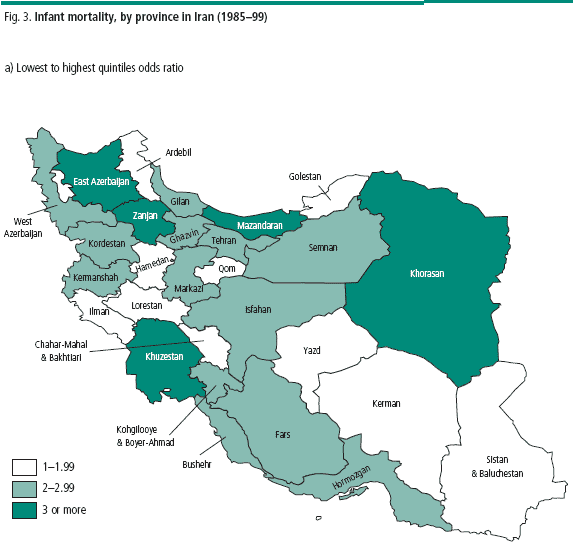RESEARCH
Socioeconomic inequality in infant mortality in Iran and across its provinces
Inégalité socioéconomique en matière de mortalité infantile en Iran et dans les différentes provinces de ce pays
Desigualdades socioeconómicas en mortalidad infantil en el Irán y en sus provincias
Ahmad Reza HosseinpoorI,1; Kazem MohammadII; Reza MajdzadehII; Mohsen NaghaviIII; Farid AbolhassaniIV; Angelica SousaI; Niko SpeybroeckI; Hamid Reza JamshidiV; Jeanette VegaI
IHealth Equity Team, Evidence and Information for Policy, World Health Organization, Geneva 27, 1211 Switzerland
IIDepartment of Epidemiology and Biostatistics, School of Public Health, Tehran University of Medical Sciences, Tehran, Iran
IIIUndersecretary Office for Health Affairs, Ministry of Health and Medical Education, Iran
IVOffice of the Deputy of Health, Tehran University of Medical Sciences, Iran
VHealth promotion & network development center, Ministry of Health and Medical Education, Iran
ABSTRACT
OBJECTIVE: To measure the socioeconomic inequality in infant mortality in Iran*.
METHODS: We analysed data from the provincially representative Demographic and Health Survey, which was done in Iran in 2000. We used a dichotomous hierarchical ordered probit model to develop an indicator of socioeconomic status of households. We assessed the inequality in infant mortality by using the odds ratio of infant mortality between the lowest and highest socioeconomic quintiles at both the provincial and national levels, and the concentration index, an inequality measure based on the entire socioeconomic distribution.
RESULTS: We found a decreasing trend in the infant mortality rate in relation to socioeconomic quintiles. The poorest to richest odds ratio was 2.34 (95% CI = 1.783.09). The concentration index of infant mortality in Iran was -0.1789 (95% CI = -0.2193-0.1386). Furthermore, the inequality of infant mortality between the lowest and highest quintiles was significant and favoured the better-off in most of the provinces. However, this inequality varied between provinces.
CONCLUSION: Socioeconomic inequality in infant mortality favours the better-off in the country as a whole and in most of its provinces, but the degree of this inequality varies between the provinces. As well as its national average, it is important to consider the provincial distribution of this indicator of population health.
Keywords: Infant mortality; Socioeconomic factors; Economic indicators; Odds ratio; Iran (Islamic Republic of) (source: MeSH, NLM).
RÉSUMÉ
OBJECTIF: Mesurer l'inégalité socioéconomique en matière de mortalité infantile en Iran.
MÉTHODES: Les données de l'enquête démographique et de santé, représentative à l'échelle provinciale, qui a été effectuée en Iran en 2000, ont été analysées. Un modèle de Probit dichotomique et ordonné hiérarchiquement a servi au développement d'un indicateur du statut socioéconomique des ménages. L'inégalité en matière de mortalité juvénile a été évaluée à l'aide de l'odds ratio (OR) de la mortalité juvénile entre les quintiles socioéconomiques inférieur et supérieur, tant au niveau provincial que national, et de l'indice de concentration, une mesure de l'inégalité reposant sur la distribution socioéconomique dans son ensemble.
RÉSULTATS: Une tendance décroissante a été mise en évidence entre le taux de mortalité juvénile et les quintiles socioéconomiques. L'odds ratio entre les plus riches et les plus démunis était de 2,34 (IC à 95 % : 1,78 - 3,09). L'indice de concentration de la mortalité juvénile en Iran valait - 0,1789 (CI à 95 % : -0,2193 à -0,1386). En outre, l'inégalité en matière de mortalité juvénile entre les quintiles inférieur et supérieur était significative et en faveur des plus riches dans la plupart des provinces. La valeur de cette inégalité était cependant variable d'une province à une autre.
CONCLUSION: L'inégalité socioéconomique en matière de mortalité juvénile est en faveur des plus riches pour le pays dans son ensemble et dans la plupart des provinces, mais le degré de corrélation varie d'une province à l'autre. Il est donc important de prendre en compte la moyenne nationale, mais aussi la distribution à l'échelle provinciale de cet indicateur de la santé de la population.
Mots clés: Mortalité nourrisson; Facteur socioéconomique; Indicateurs économiques; Odds ratio; Iran (République islamique d') (source: MeSH, INSERM).
RESUMEN
OBJETIVO: Medir las desigualdades socioeconómicas en términos de mortalidad infantil en el Irán.
MÉTODOS: Analizamos datos de la Encuesta de Demografía y Salud realizada en el Irán en 2000, con datos representativos de las provincias. Utilizamos un modelo probit dicotómico jerarquizado para elaborar un indicador de la situación socioeconómica de los hogares, y procedimos a evaluar las desigualdades en mortalidad infantil utilizando la razón de posibilidades de esta mortalidad entre los quintiles socioeconómicos inferior y superior a nivel tanto provincial como nacional, así como el índice de concentración, una medida de desigualdad basada en la distribución socioeconómica general.
RESULTADOS: Hallamos una tendencia decreciente de la tasa de mortalidad infantil en relación con los quintiles socioeconómicos. La razón de posibilidades entre el más pobre y el más rico fue de 2,34 (IC95%: 1,78-3,09). El índice de concentración de la mortalidad infantil en el Irán fue de -0,1789 (IC95%: de -0,2193 a -0,1386). Además, la desigualdad en mortalidad infantil entre los quintiles inferior y superior fue significativamente favorable a los más acomodados en la mayor parte de las provincias. Sin embargo, la magnitud de la desigualdad difería de una provincia a otra.
CONCLUSIÓN: Las desigualdades socioeconómicas en mortalidad infantil son favorables a los más acomodados tanto en el conjunto del país como en la mayoría de sus provincias, pero el grado de correlación varía según la provincia. Además de la media nacional, es importante tener en cuenta la distribución por provincias de este indicador de la salud de la población.
Palabras clave: Mortalidad infantil; Factores socioeconómicos; Indicadores económicos; Razón de diferencia; Irán (República Islámica del) (fuente: DeCS, BIREME).
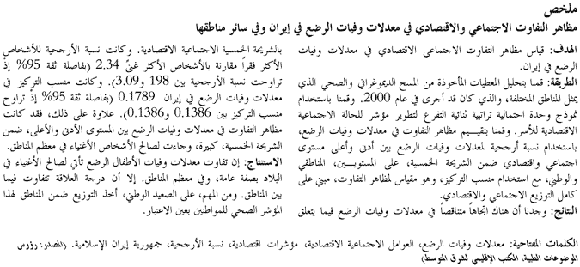
Introduction
More than 10 million children die each year in the world (1). That is why child mortality has received renewed attention as part of the United Nation's Millennium Development Goals (2). Furthermore, evidence worldwide suggests that children in households with a lower socioeconomic status have higher mortality rates (39). Few studies have been carried out on inequalities in infant and child mortality in developing countries before the last decade, but this situation has recently begun to change. Recent attention to the differences in health status between the poor and rich has led to more research on the health of different groups in developing countries (10). The inter-country projects initiated by WHO and World Bank provide basic information on the health status of different groups (11, 12).
Over the last two decades in Iran there has been a significant declining trend in infant mortality rates with 63.5, 43.5, and 26.7 per 1000 livebirths in 1988, 1994 and 2000, respectively (13, 14). However, no studies have been done on differences in infant mortality rates across socioeconomic groups in Iran. We measured the socioeconomic inequality in infant mortality in Iran overall, as well as in each of its provinces.
Methods
Data
We extracted data from the Demographic and Health Survey (DHS), which was conducted in Iran in 2000 (14). The sample population of DHS constituted 4000 households (2000 rural and 2000 urban) from 28 provinces of the country, plus 2000 households in the capital, Tehran. The sampling design consisted of a stratified single stage (equal size) cluster sampling with unequal sampling probabilities. The specific design and sample size (4000 households) make this survey representative at the sub-national level (14).
In addition, we studied 110 751 households to define the socioeconomic status of households in Iran. To define the socioeconomic inequality in infant mortality, we analysed 47 896 livebirths from 1995 to 1999 at the national level and 187 292 livebirths from 1985 to 1999 at the provincial level.
Selection of a five-year observation period at the national level and a fifteen-year observation period at the provincial level is a compromise between providing recent estimates and ensuring enough births to reduce the effects of sampling error (15).
Analysis
We used a dichotomous hierarchical ordered probit (DIHOPIT) model to develop an indicator of the long-running economic status of households (16). It is based on the premise that wealthier households are more likely to own a given set of assets, thus providing an estimate for economic status index for households. We used the following indicators: owning a refrigerator, a television, a telephone, a car, a motorcycle, a bicycle, a bathroom, a toilet, type of heating system, use of natural gas for cooking and heating, number of rooms per capita, type of bathroom effluent disposal, status of toilet sanitation, type of solid garbage disposal, and main source of drinking water. Furthermore variables considered as predictors of the household's economic status included age, sex, education, marital status of the head of the household and migration history of the household five years prior to the interview.
In addition to creating a national index of household economic status, we estimated economic indices for each province separately based on the assumption that province-specific information would produce a more effective and accurate index. Therefore we calculated separate economic indices to discover the socioeconomic status of the sampled populations within each province.
We selected a binary outcome variable: namely whether or not each of the live born infants of the women interviewed was still alive or not in the 12 months following birth. We estimated the infant mortality rate (number of deaths among children below one year of age divided by 1000 livebirths reported during the above-mentioned periods) from birth histories for the entire country and for each province separately. We defined the socioeconomic inequality in the infant mortality rate using two parameters: the infant mortality concentration index and poorest to richest quintiles odds ratio of infant mortality rate. The concentration index, whose value can vary between 1 and +1, has frequently been used in the study of income-related inequalities (17). Its negative values imply that the health variable is concentrated among disadvantaged people while the opposite is true for its positive values. When there is no inequality, the concentration index will be zero. We used regression analysis to compute a weighted estimate of the concentration index, taking into account the clustering for the confidence interval (18).
In the analysis we considered the DHS stratification and unequal sampling weights as well as household clustering effects. To exclude any sampling variation, we used LIMDEP and STATA to calculate the DIHOPIT and odds ratios, as well as concentration indices, respectively. These programmes can take into account the specific stratified weighted and clustered design issues.
Results
Table 1 shows the infant mortality rate and standard deviation for different socioeconomic quintiles at the national level. It also shows the odds ratio for infant mortality rate and 95% confidence interval for the different quintiles, with the richest quintile being used as the reference category. As indicated in Fig. 1, there is a descending trend in the infant mortality rate, the higher one moves up the socioeconomic quintiles. Fig. 2 illustrates the concentration curve of infant mortality for Iran, indicating the concentration of infant mortality among people of low socioeconomic status. The concentration index indicating socioeconomic inequality of infant mortality in Iran was -0.1789 (95% CI = -0.2193-0.1386).

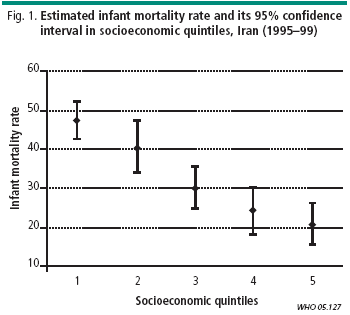
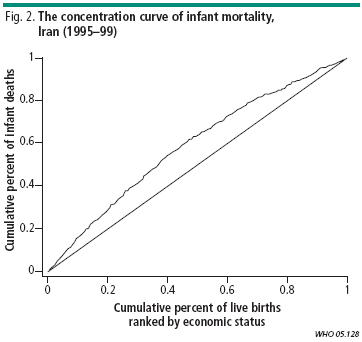
Table 2 shows the infant mortality rate, its standard deviation for different socioeconomic quintiles, and measures of socioeconomic inequality in infant mortality rates for each province. Provinces such as Khuzestan, Markazi, Tehran and West Azerbaijan, show a descending trend in infant mortality rate as a function of socioeconomic quintiles as observed at the national level. The relative difference in infant mortality rates between lowest and highest quintiles was statistically significant in all provinces except in Ardebil, Chahar-Mahal & Bakhtiari, Golestan, Hamedan, and Lorestan. Among the provinces with a statistically significant odds ratio, the ratio varied from 1.55 in Sistan & Baluchestan to 4.07 in East Azerbaijan. Based on the concentration index, inequality in infant mortality was also statistically significant in all provinces except for Qom. This measure ranged from -0.0632 in Ardebil to -0.2389 in Khuzestan among provinces with a statistically significant concentration index.
Fig. 3a and Fig. 3b illustrate the map of Iran according to the socioeconomic inequality in infant mortality across provinces based on odds ratio and concentration index, respectively. There is no obvious geographical clustering of inequality across provinces.
Fig. 4a and Fig. 4b plot infant mortality inequality for all provinces based on odds ratio and concentration index, respectively. According to Fig. 4a, provinces can be grouped into distinct categories:
those with a low average and no or low inequality, such as Ilam, Lorestan and Qom;
provinces with a high average but no or low inequality, such as Sistan & Baluchestan and Ardebil;
those with a low average but high inequality like Khuzestan and Mazandaran;
provinces with high average and high inequality such as Zanjan and East Azerbaijan; and
provinces whose average and inequality values are close to the corresponding national values calculated for the same period (2.71 and 41.2 for the national inequality and average infant mortality, respectively). Markazi and Ghazvin are two provinces in this group.
In addition, we grouped some provinces on the basis of the average infant mortality to the concentration index (Fig. 4b):
provinces with a low average and no or low inequality, such as Qom, Lorestan and Ilam;
provinces with a high average but low inequality, such as Sistan & Baluchestan and Ardebil;
the province of Khuzestan, with a low average but high inequality; and
the province of Khorasan, with a high average and a high inequality.
Most remaining provinces had a medium level of inequality.
To see whether variations in availability of health services among provinces could explain these differences in the inequity and the average of infant mortality, we calculated the availability of health houses by dividing the number of active health houses in each province in 1999 by the number of health houses needed for that province based on the size of the population. Table 3 shows the availability of health houses the lowest level of health care delivery system in rural areas in each province in 1999 (19). We observed that the correlation between the average infant mortality and availability of health care was not high across provinces. For example, Markazi was one of the provinces with a high concentration of infant mortality among the poor, despite the availability of health care delivery for almost all its people.
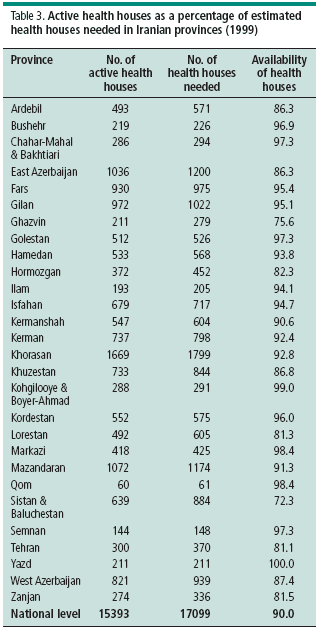
Discussion
This study is one of the first to show the spatial distribution of the inequity of infant mortality within a country. Furthermore this study fills a gap concerning the lack of information on infant mortality within a region. This study shows that there is a reverse association between infant mortality rates and socioeconomic status across Iran as a whole and within most of its provinces.
As shown in Figs 4a and 4b, the degree of socioeconomic inequality depends to some extent on the parameter used. The concentration index expresses the inequality in health across the full spectrum of socioeconomic status. In contrast, poorest to richest odds ratio does not take into account the health status of the three middle quintiles. Yet it does have the merit of being readily interpretable and accessible to policy-makers in comparison with concentration index (15). For instance, in spite of the fact that East Azerbaijan and Fars had the same concentration of infant mortality among the poor, the former had the largest inequality according to the poorest to richest odds ratio while such a difference was moderate in the latter.
However, most regions showed the same order of inequality when ordered in three groups (Figs 3a and 3b), confirming the observation that simple measures of regional inequality often yield estimates comparable with those based on the entire population (20).
Our findings are consistent with results obtained from other studies in different parts of the world. A study on inequalities in child mortality in nine developing countries using consumption levels as the measure of socioeconomic status found that countries with a more unequal consumption distribution in the population tended to have greater inequalities in child mortality than those with a more equal distribution of consumption (4). In a health survey conducted in the state of Kerala in India, Kutty, Thankappan, Kannan and Aravindan developed a rating of socioeconomic position taking into account factors including income, education, housing conditions and land ownership. The lowest socioeconomic status group had the highest child death rates (5). Poerwanto, Stevenson and Klerk found that the risk of infant mortality among households of low welfare index in Indonesia was almost twice that of households with high welfare index (6). A Chilean study from 1990 to 1995 showed a clear gradient of infant mortality rates according to the mother's level of education. The highest rate of infant death was among those with no education (7).
In another study in a Brazilian city, the mortality rate among infants was negatively related to geo-economic classification, with poor areas of the city having the highest rates and rich areas the lowest (8). Developed countries whose overall infant mortality rate is low have demonstrated similar patterns. For instance, a population-based study in Norway showed an inverse association between socioeconomic groups and risk of infant death from 1967 to 1998. Parents' education was used as a measure of socioeconomic status. The researchers concluded that in spite of low infant mortality rates, the socioeconomic inequality in the risk of infant death is an indicator of important societal phenomena (9).
Different parameters have been used as proxy measures of the socioeconomic status of households, such as parents' education, occupation of the household's head, monetary measures and non-monetary economic indices (49, 12). In this study, we focused on the last approach given that the DHS has not collected data on self-reported income and expenditure, but provides information on ownership of asset indicator variables. The World Bank's Living Standards Measurement Study may be more appropriate for capturing data on living standards, but it has not been done in Iran. DIHOPIT is one of the statistical methods developed to create non-monetary economic indices for households (16). By enabling us to rank households according to their socioeconomic status, such indices provide a measure of relative economic status within a country, and are therefore invaluable in comparative analyses over time and place. This approach of establishing a household's economic status in the absence of information on income and expenditure greatly extends the possibilities for inequality analyses.
The DIHOPIT approach has been validated with nationally representative surveys carried out in three countries Greece, Pakistan and Peru with considerably different socioeconomic characteristics (16). This study showed that DIHOPIT correlated closely with income and expenditure.
The objective of our study is not to rank provinces according to their inequality, but to show that measuring the average health status in isolation is not sufficient enough to describe the health of a population. Moreover the distribution of health in the population is also a key concern to be considered during health planning and policy-making for promotion of health.
Gakidou King showed that the causes of inequality in child mortality rates are related to, but are quite distinct from, the causes of average level of childhood mortality (21). They suggested that variables that predict inequality need to be further researched, even if they do not predict average level of child mortality. This study demonstrates that differences across provinces exist in both the inequity as well as in the level of infant mortality.
We can deduce the reasons for the existing conditions from experts as well as from local information in some provinces, but there is little research-based evidence to provide clear explanations, especially in urban areas. For instance, utilization of health care facilities in Sistan & Baluchestan is known to be far less than the rest of the country not only because of low availability of health care, but also as a result of people's attitude (14). This study indicates the necessity of better defining the determinants of both inequality and levels of infant mortality as well as the contribution of each factor to different provinces.
Conclusion
Our results suggest that socioeconomic inequality in infant mortality favours the better-off in Iran as a whole and in most of its provinces, and that this inequality varies between provinces. Investigating why inequality favours the better-off and why it is higher in some provinces deserves special attention. In addition, it is advisable to conduct provincially representative surveys to provide recent estimates of health inequalities and to allow monitoring over time. 
Acknowledgements
We thank Ajay Tandon, Alec Irwin, Laura Pearson, Yaniss Guigoz and Steeve Ebener. We thank the UNICEF DevInfo project for providing the original map of Iran.
Competing interests: none declared.
References
1. Black RE, Morris SS, Bryce J. Where and why are 10 million children dying every year? Lancet, 2003, 361:2226-34.
2. Millennium Development Goals: a compact among nations to end human poverty. New York, United Nations Development Programme (UNDP), 2003.
3. Claeson M, Gillespie D, Mshinda H, Troedsson H, Victoria CG. Knowledge into action for child survival. Lancet, 2003, 362:323-7.
4. Wagstaff A. Socio-economic inequalities in child mortality: comparison across nine developing countries. Bull World Health Organ, 2000, 78: 19-29.
5. Kutty VR, Thankappan KR, Kannan KP, Aravindan KP. How socioeconomic status affects birth and death rates in rural Kerala, India: results of a health study. J Health Services, 1993, 23:373-86.
6. Poerwanto S, Stevenson M, Klerk N. Infant mortality and family welfare: policy implications for Indonesia. J Epidemiol Community Health, 2003, 57:493-8.
7. Hollstein RD, Vega J, Carvajal Y. [Social inequalities and health. Socioeconomic level and infant mortality in Chile in 1985-1995]. Rev Méd Chil, 1998, 126(3):333-40 (in Spanish).
8. Goldani MZ, Barbieri MA, Bettiol H, Barbieri MR, Tomkins A. Infant mortality rates according to socioeconomic status in a Brazilian city. Rev Saúde Pública, 2001, 35 (3):256-61.
9. Arntzen A, Samuelsen SV, Bakketeig LS, Stoltenberg C. Socioeconomic status and risk of infant death: a population-based study of trends in Norway, 19671998. Int J Epidemiol, 2004, 33 (2):279-88.
10. Gwatkin DR. Poverty and inequalities in health within developing countries filling the information gap. In: Leon DA, Walt G, eds. Poverty, inequality, and health: an international perspective. Oxford, Oxford University Press, 2001.
11. The world health report 1999: making a difference. Geneva, World Health Organization, 1999.
12. Socio-economic differences in health, nutrition, and population: 45 countries. Washington, DC, The World Bank Group, 2000.
13. Human development report of the Islamic Republic of Iran. Tehran, Plan and Budget Organization of the Islamic Republic of Iran and United Nations in the Islamic Republic of Iran, 1999.
14. Population and health in the Islamic Republic of Iran. Iran Demographic and Health Survey Report. Tehran, Ministry of Health and Medical Education, 2000.
15. Anand S, Diderichsen F, Evans T, Shkolnikov VM, Wirth M. Measuring disparities in health: methods and indicators. In: Evans T, Whitehead M, Diderichsen F, Bhuiya A, Wirth M, eds. Challenging inequities in health: from ethics to action. New York, Oxford University Press, 2001.
16. Ferguson B, Murray CJL, Tandon A, Gakidou E. Estimating permanent income using asset and indicator variables. In: Murray CJL, Evans DB, eds. Health systems performance assessment: debate, new methods, and new empiricism. Geneva, World Health Organization, 2003.
17. Wagstaff A, Paci P, van Doorslaer E. On the measurement of inequalities in health. Soc Sci Med, 1991; 33:545-57.
18. Zere E, McIntyre D. Inequities in under-five child malnutrition in South Africa. Int J Equity Health, 2003, 2:7.
19. Naghavi M, Jafari N, Jamshidbeigi E, Vasegh H. Ten-year performance assessment of primary health care system in the rural areas of the Islamic Republic of Iran. Tehran, Ministry of Health and Medical Education, in press.
20. Manor O, Mattews S, Power C. Comparing measures of health inequality. Soc Sci Med, 1997, 45(5):761-71.
21. Gakidou E, King G. Determinants of inequality in child survival: results from 39 countries. In: Murray CJL, Evans DB, eds. Health systems performance assessment: debate, new methods, and new empiricism. Geneva, World Health Organization, 2003.
(Submitted: 01 December 2004 Final revised version received: 01 June 2005 Accepted: 30 June 2005)
This article has received corrections in agreement with the ERRATUM published in Volume 83 Number 12.
1 Correspondence should be sent to Dr Hosseinpoor at this address: (e-mail: hosseinpoora@who.int).
* The Islamic Republic of Iran

